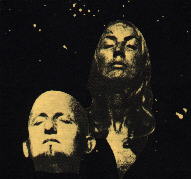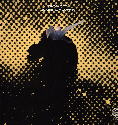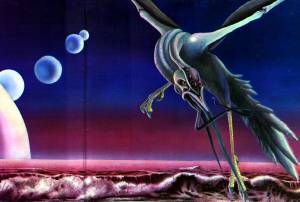Glass Top Coffin
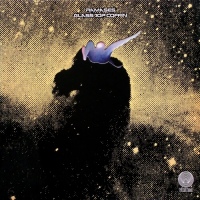 | 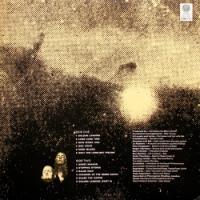 |
Cover scans from Time Has Told Me | |
"The dreamer dreamed the dust rose up andwalked
But when the dreamer woke did anyone tell the dust
-and I fell-
and stars like dust covered me"
Original LP released in 1975 on Vertigo6360 115
Released on CD by Esoteric Recordings (catalogue no. ECLEC2184) in March 2010
Rare: This album is quite rare and is worth a bit on the collector'smarket, more so in fact than 'Space Hymns'.
-- Leon Economides, January 1999
Australian CD: I bought a newly released Ramases "Space Hymns" CD on eBay - it has six bonus tracks from "Glass Top Coffin" which are tracks 2, 3, 6, 9, 10 and 11. CD is on Progressive Line a division of Dole Music - Made in Australia P 1971/75 C 2001. More here...
-- Mike Sonnabend, 31 January 2002
Produced by Ramases and Barry Kirsch,recorded at Phonogram Studios, London
All songs written by Ramases and hiswife Sel
Cover concept by Ramases, artwork byDave Field/art direction: Jack Wood
Album Cover: He was really upset by the cover of the album. I saw the first proofs andthey weren't at all what he envisaged. The cut-out was meant to show a manfalling backwards into space into the Horsehead nebula, which when you openup the album revealed that bird. Well, he didn't like what they had done,but the artwork was completed and the record company said, that's that!! SoRam persuaded the record company to let him scratch (literally) the lithoplates before the cover went to press. He sanded down that little circlethat is lighter in the mans head that forms a part of that birdsshoulder, and it did look marginally better. His vision was that the manwould look like he was in a space suit with helmet on, etc etc...
-- Paul Hollyer, September 2000
Click on song title for lyrics
- Golden Landing [6:05]
- Long, Long Time [5:16]
- Now Mona Lisa [2:59]
- God Voice [3:18]
- Mind Island [4:37]
- Only The Loneliest Feeling [3:01]
- Sweet Reason [5:48]
- Stepping Stones [4:30]
- Saler Man [5:06]
- Children Of The Green Earth [3:31]
- Glass Top Coffin [4:02]
- Golden Landing (Part II) [2:23]
Tracks:
Listen to an MP3 of Saler Man.
- Ramases and Sel: Lead vocals and acousticguitars
- Jo Romero: Acoustic and electric guitars,Tablas
- Pete Kingsman: Electric and stringBass
- Roger Harrison: Drums and tuned percussion
- Barry Kirsch: Piano, Synthesizer
- Colin Thurston: Bass on 'LongLong Time'
- Kay (Garner), Sue (Glover) & Sunny(Leslie) and the Eddie Lester Chorale: Backing vocals
(Sue and Sunny were from the Brotherhood Of Man) - Bon Bertles (of Nucleus): Sax
- Orchestra: Members of the Royal Philharmonicand London Symphony Orchestras
- Orchestral arrangements by Rob Young
Musicians:
Glass Top Coffin - inside gatefold - supplied by Adrian, October 1999
Review:
Read a track-by-track review by Nigel Camilleri here...
2010 CD re-issue:
Sleeve notes by Jon Wright, published here by kind permission of Jon Wright and Vicky Powell (from Esoteric Recordings)
With a name that means –‘born of the sun-god Ra’, Ramases, or indeed as modern Egyplogists have it Ramesses, is the name that is conventionally used to describe the names of 11 Egyptian pharaohs of the New Kingdom period of the country’s history. It’s no surprise therefore, that when Mr Martin Raphael from Sheffield, was visited by one of the great kings himself in a vision, that he took the name of his visitor, renamed his wife, Dorothy Frost, Selket, after the Egyptian Goddess of cures and set out to make music. Once you’ve met a Pharaoh, I assume you just have to do something extravagant to honour them. Like a British Moondog then, Ramases embarked on the practice of strange costume and strange behaviour. The music he made, whilst perhaps equally strange to some, bears the hallmarks of serious endeavor and forethought. Spaced, conceptual and unashamedly grandiose, and cut with outstanding musicians on board, the two albums that Ramases released are now both cult prig classics, released on the equally cult prig label – Vertigo. Having never had an official UK release on CD until now, this is the first release of the record since the original on Vertigo in 1971.
Martin Raphael was born in the late 1930’s in Sheffield. After childhood he became a PT instructor with the army moving to Scotland to sell double glazing or central heating (no-one seems to be sure) after his conscription was over. One day, parked up in his car, Raphael claimed he was visited by the Egyptian king and told to spread the truth about the universe to the troubled and discordant world out there. Raphael agreed, changing his name and his identity to Ramases, (one assumes here that he was calling himself after Ramases the Great and not one of the lesser Ramases). Either way, he then got serious, wearing old Egyptian clothes and scouting, along with his renamed and clearly understanding wife, for a record label willing to help him in his quest. All this would be laughable of course if that had been the end of it.
Incredibly, it was the mighty American label Columbia Records, known outside it’s native land as CBS that saw the potential in Ramases, offering him a contract to record a single. Crazy One/Mind’s Eye (CBS 3717) came out in 1968. Now ultra-rare, the single changes hands for upwards of £70. Those who want the song but not the artifact however, can find it on the Exploding Plastic Inevitable Vol 2 compilation and on Vol 3 of the famous Rubble series on Voiceprint Records. The space theme that was to define his artistic direction should have begun here, but someone at CBS misheard the original title, Quasar One and listed it as it now appears. The cover depicted the pair of them in Egyptian garb, the bold Ramases, looking for all the world like Imhotep from the recent Mummy films. Mind’s Eye was also released on a Mojo compilation, ‘Acid Drops, Spacedust and Flying Saucers’ in August 2001. For the first single, the duo called themselves Ramases and Selket. After the failure of the single, they were dropped by CBS and signed with a much smaller label to try again. Now under the name Ramases and Seleka, a name with no obvious Egyptian connotations, the pair released Love You/Gold is the Ring, on Major Minor Records, (MM 704), again in 1968. Less rare than its predecessor, the single will still set you back £20 nowadays. The single failed, again to have any impact and for a couple of years, Ramases and Selket/Seleka all but disappeared.
As befits a legendary king of old however, his return was both triumphant and beautifully timed. Vertigo, the spiral label of which is now virtually synonymous with the high years of progressive rock, signed Ramases in 1970. Without a band at this point, the pair located to Strawberry Studios in Stockport to record their debut, Space Hymns. The studio was owned by four chaps who were to have a lasting impact on the UK music scene themselves as 10cc. Kevin Godley, Eric Stewart, Graham Gouldman and Lol Crème would form the band in 1972, but at this point they were free to help Ramases and help him they most certainly did. Space Hymns was relased on the label in 1971,( Vertigo 6360 046). Replete with a dramatic and beautiful painting by Roger Dean on the cover, the inside folded out into a huge, solarized poster of Ramases and Selket holding ears of corn in retrospect it looks for all the world like a progressive rock album – but it isn’t. Decidedly folky in tone, with the hippy tinges one might expect from Amon Duul or Quintessence, it was really a psych record that found its audience in the prog market as a welcome anomaly. A counterpoint perhaps to the endless tempo and time-signature twiddling of labelmates like Gentle Giant or Cressida and full of tantric chanting and quasi-religious overtones. Two singles were released from the debut, Ballroom/Muddy Water, (Phillips 6113 001) and Jesus Come Back/Hello Mister ,(Phillips 6113 003) – once again neither, perhaps unsurprisingly, bothered the pop charts.
After the release, Ramases and Selket moved south to Felixstowe and again, a hiatus followed and not much is really known about what they did in this time. There were almost certainly no live dates.
Then, in 1975, Ramases and Selket returned with this masterpiece, Glass Top Coffin. Co-produced by Ramases and keyboardist Barry Kirsch, the album was markedly different from the debut. More eclectic and certainly more professional it was another concept album based on space themes. Orchestral arrangements gifted by members of the Royal Philharmonic Orchestra and the London Symphony Orchestra clearly helped Ramases to fashion his space hymns into a space opera. Confident perhaps in their abilities with a solid recording set-up Ramases and Selket both found their voices on this record. Their duet on Now Mona Lisa being a seductive and beguiling standout.
Elsewhere, tracks like the dittyish Long, Long Time and Saler Man found the pair surfing a way between pop and prog to a degree that shames many other bigger names of the time. Gone was the chanting and quasi-religious babble, to be replaced by an altogether firmer song cycle – in short, this is a more considered and better orchestrated record. An indication that during his hiatus, Ramases had matured significantly as a musician and songwriter.
The cover was a sticking point for Ramases, who clearly had an acute aesthetic sensibility. The cover was designed by him with artist Dave Field, but a mistake in the production, which lead to the figure on the cover not being pop-out as he had planned annoyed him just enough to lose interest. Ramases were no more and after poor sales he retreated from the industry.
Ramases left very little behind him, but this masterpiece is justification enough for his extravagant claims and outlandish dress. Melancholy, uplifting, though still strange enough to be cult, the album has continued to garner worldwide praise. Selket has recently resurfaced to discuss the albums on various fan sites and forums from here to South Africa and Germany, where the albums became immensely popular. She claims that she has tried to forget most of what they did. If true, that would be sad enough, but the death of Ramases at his own hand in the late seventies reads like an Egyptian tragedy. Only the Loneliest Feeling and Mind Island take on an added poignancy in the light of this, full of innate sadness and dark melancholy, they also indicate the hand of a sensitive and heartfelt songwriter. Ramases may have gone to the spirit word, but his legacy lives on in his music and this is the best of it.
INTRODUCTION |BIOGRAPHY |DISCOGRAPHY |FORUM |LINKS
